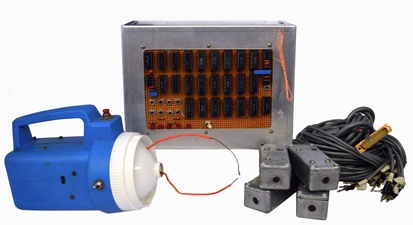Archaeological Field Mapping System
- Material :
- Ray-O-Vac flashlight body, wires, metal boxes, sonar, motherboard
- Designer :
- Bob Roswell
- Year :
- 1972
Seeing how time-consuming this process is, Bob decided to create a system that would make this much faster and accurate as a senior project. The system he devised starts with an old Ray-O-Vac model no. L295 flashlight converted with a switch and some wires that when you press a button a loud spark would sound. You would do this at the exact location at which an object was found and then the sound would travel to 4 small metal boxes equipped with sonar that would receive the sound. These boxes would be place in a few places around the place at which the object was found at varying distances. By wires the small boxes are connected to larger box with a motherboard that would convert the sound into data, recording the time it took for the sound to get from the object location to the sonar boxes. This data would be transmitted to a computer, put through a program which would simply apply the distance = rate times time (d=rt) to the data and record the point on the grid. This whole process would only take a few moments compared the old laborious process. Again, something that would normally require intense measuring by hand now would take minutes with a push of a button.

